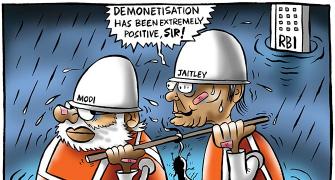'The hour is very late, and the choice between triumph and tragedy knocks at our door,' says Ajay Shah.
Illustration: Uttam Ghosh/Rediff.com

High- and low-productivity firms manage to coexist in India when low-productivity firms cheat on compliance.
To the extent that a sound GST improves compliance, many low-productivity firms will exit.
A sound GST will also disrupt many vertically integrated firms and we will see more trades between specialised industries.
The banking crisis has slowed the traditional ways of ever-greening, which keeps zombie firms aloft.
RBI reforms, the Insolvency and Bankruptcy Code (IBC), and the resolution corporation will help shift capital from weak firms to healthy firms.
These factors suggest that a large restructuring of the economy is underway.
This is a daunting scale of churning in the economy.
Done right, this will give a new wave of GDP growth. Implementation teams in government hold the key.
Three forces are now reshaping the Indian economy.
The first is the impact of the goods and services tax on low-productivity firms.
Under normal conditions, competition in markets induces creative destruction. Weak firms exit.
This improves the supply of labour and capital to healthy firms at lower prices. It also improves the pricing power of healthy firms.
When capitalism works, the exit of weak firms improves the profitability of healthy firms.
This is not what we see in India.
High-productivity and high-compliance firms coexist with low-productivity and low-compliance firms.
Low-productivity firms survive by violating health/safety/environment regulations, and cheating on taxes.
This harms overall productivity and GDP.
The self-enforcing nature of the GST will reduce cheating on taxes. Many firms will be forced to either raise productivity or exit.
The second element is also related to the GST.
In India, we have traditionally had taxation of transactions.
In the delicate jargon of public finance, all transaction taxes are 'bad taxes'.
If production is organised as firm A making engines and firm B making cars, then the taxation of transactions results in double taxation.
This encourages vertical integration: Automobile companies would prefer to make their own engines. However, the essence of high productivity is specialisation.
A sophisticated economy is one in which there are a large number of highly specialised firms that trade with one another.
GST reduces the extent of taxation of transactions and thus reduces the artificial incentive for vertical integration.
Many firms have gone through great pain in recent decades to achieve vertical integration.
These firms will encounter difficulties when India achieves more specialised industries that trade intensively with one another.
The third element is about zombie firms.
In an ideal world, when it is clear that a firm does not work, it should be rapidly dissolved.
In India, these walking dead have been kept alive by injections of capital from banks. This process is coming under increasing stress.
Any one operational creditor who is not paid on time can trigger the IBC.
Any one employee who is not paid a salary on time can trigger the IBC.
Any one financial creditor can trigger the IBC.
Once any one person initiates the IBC proceedings, it becomes impossible for banks to keep up the facade of a standard asset.
High-productivity firms will be able to bring in enough equity capital and run a tight finance operation so as to make all payments on time.
Low-productivity firms will stumble. This will give more exit of low-productivity firms.
A Joint Parliamentary Committee of Parliament is examining the law that creates the 'Resolution Corporation' (RC), envisaged by Justice B N Srikrishna's Financial Sector Legislative Reforms Commission (FSLRC).
This will improve the pace of exit of weak financial firms, and thus bring greater discipline upon the use of financial capital in the economy.
These three forces add up to a large-scale churning of the economy.
Each of the three will impact upon the length and breadth of the country, upon firms large and small.
Even with the best implementation teams on the policy side, there will be a slow process of reconstructing Indian capitalism in these directions.
This will require new conceptions of the boundary of the firm, and of processes and technologies within firms. These changes call for building new kinds of organisational capital in all firms.
As an example, there will be opportunities for high-productivity firms to grow dramatically. These firms may be able to buy going concerns or assets that come up for sale through the IBC.
These firms will see an economy with lower wages, cheaper capital, and higher product prices. Their challenge will be in reshaping themselves to harness these opportunities.
These are valuable and positive features of the outlook for India. However, there are four bottlenecks in the zone of public policy.
What do policymakers need to achieve?
A sound GST is one with a single rate, a low rate, a comprehensive base, and a unified and capable administration.
Bankruptcy reform requires the following inputs: Fixing the mistakes in the 2016 law; building the Insolvency and Bankruptcy Board of India (IBBI) into a high-performance organisation; sound regulations; three new private competitive industries for information utilities (IUs), insolvency professionals (IPs), and insolvency professional agencies (IPAs); a capable National Company Law Tribunal and Debt Recovery Tribunal; correcting mistakes in regulation which shapes how financial firms use the levers of the IBC; and correcting mistakes in regulation which hampers the pool of buyers for distressed assets.
RBI reforms are required to put banking regulation and supervision on a sound footing.
The Resolution Corporation requires enacting a sound law.
After the FSLRC report of 2013, the ministry of finance had set up a 'Task Force on the Establishment of the Resolution Corporation' led by M Damodaran, in 2014.
It has written an implementation plan for constructing the Resolution Corporation. This plan needs to be put into motion so that a high-performance organisation is built rapidly.
If good implementation teams are put into these four areas, India will translate this phase of structural change into stunning growth.
If weak implementation persists, this great churning will turn into a decade-long stagnation.
The hour is very late, and the choice between triumph and tragedy knocks at our door.
Ajay Shah is a professor at National Institute of Public Finance and Policy, New Delhi.










